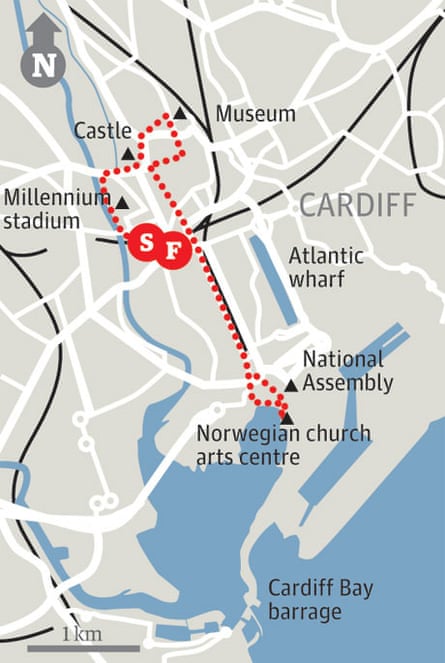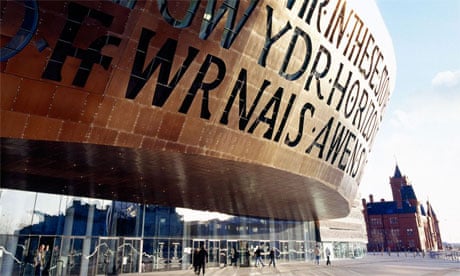Walk in a nutshell
An easy walk taking in the architecture - old and new - of the cosmopolitan capital of Wales. Starting near the Millennium Stadium, you walk up the River Taff to Cardiff Castle before heading over to the newly regenerated Cardiff Bay area to see the Welsh assembly building and the Millennium Centre.
Why it's special
Some spectacular modern buildings came out of the regeneration of Cardiff that took place around the millennium. The Millennium Centre, locally nicknamed "the Armadillo", is an arts centre in the Bay area. Designer Jonathan Adams wanted a building that expressed "Welshness", and it was built with local materials that reflect the different parts of Wales. The centre's main feature, the bronze-coloured dome, inscribed with verses in Welsh and English, is clad in riveted steel treated with copper oxide. It reflects South Wales's industrial past and was designed to look better with age. The multi-coloured layers of slate represent the stone layers in sea cliffs and reflect the slate quarries of the north. The Senedd (senate), the debating chamber of the Welsh assembly, was similarly built with local materials like slate and Welsh oak. It was also designed to be environmentally friendly: it uses an "earth heat exchange" system for heating, rainwater is collected from the roof and used for flushing toilets, and the roof funnels light and air into the debating chamber below. Like the Cardiff Bay area, Cardiff Castle has been through several regenerations of its own. Originally a Roman fort, it became a Norman stronghold before being turned into a Gothic fairytale fantasy by the Victorians.
Keep your eyes peeled for
Waders and water birds such as herons, coots and cormorants. Also the wall of Bute Park, topped with animal figurines.
But bear in mind
There is a bus station near the train station and a lot of construction work going on, so the roads in that area are very busy. Over the past year some of the one-way systems have changed direction and some roads now only have access for buses.
Recover afterwards
There are a plenty of chain restaurants looking out over the bay, but if you make the effort, the Armless Dragon serves excellent contemporary Welsh food, including Welsh black beef, rabbit, pigeon and guinea fowl. It's a mile north of the city centre on Wyeverne road: armlessdragon.co.uk
If it's tipping down
The National Museum of Wales is also worth a visit and has a notable collection of Impressionist paintings: museumwales.ac.uk
How to get there
By car
There is a small car park next to the station and a larger one behind it on Penarth road.
By public transport
The walk starts at Cardiff Central station.
Step by step
1. Turn left out of the station to the road and follow it left at the traffic lights.
2. Cross the road to the Millennium Stadium. You can walk up either side of the River Taff to the next waymark. The left side gives a better overall view of the stadium but the right bank reveals more character in the personalised paving stones and other adornments.
3. At Cardiff Bridge, turn right with the stadium on your right. Opposite is Bute Park, whose wall is topped by stone animals scrambling over it.
4. Follow the castle wall round to the left. The first subway that you come to was originally a bridge carrying the road over the Glamorganshire canal.
5. At the corner of the castle take the second subway to come out by City Hall and the law courts. Proceed along the fronts of these buildings.
6. Take the road (Park Place) running right towards the town centre with the park to your right. Cross Boulevard de Nantes at the lights and continue straight on.
7. At the Thistle hotel turn right into Queen Street, one of Cardiff's principal shopping areas.
8. At the statue of Aneurin Bevan, with the castle in front of you, turn left into Saint John Street. Walk round to the right of Saint John the Baptist's church with Cardiff market on your right. Carry straight on into the Hayes.
9. Continue down the Hayes with a large redevelopment site on the left. Go past the Golden Cross pub and the Marriott hotel on the right and continue under the railway into Bute Street. Keep straight on to Mermaid Quay. There are a number of galleries and exhibition spaces on the way. Notice also the grand scale of the buildings like the banks, dating from when this was the world's busiest port.
10. At Mermaid Quay, descend the steps to the waterfront. Notice the old signals that used to control the paddle steamers that plied across the Bristol channel. (From here you can take a 45-minute boat trip up the Taff to the Millennium Stadium). With your back to the sea, head right, past the bronze Celtic ring sculpture by Harvey Hood.
11. Keeping the sea on your right, walk past the Pier Head building - the former dock offices - and continue round to the right. Pass the Welsh assembly building (Senedd) on your left.
12. The Norwegian Church arts centre is the furthest point of the walk.
Retrace your steps to the Pier Head building and turn right before you reach the footbridge over the basin.
13. Pass the Millennium Centre and continue up Lloyd George Avenue (which parallels Bute Street) with the County Hall building on the right. At the end, turn left on Herbert Street under the railway, cross Bute Street and walk past the curving office development. When you reach a roundabout with a statue, turn right under the railway then left past the gothic hotel into Saunders Road to return to the start.

